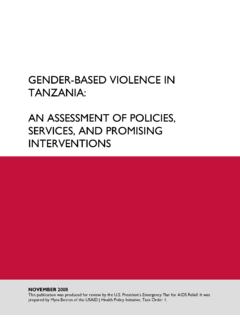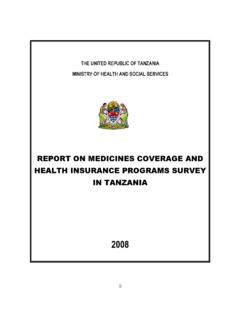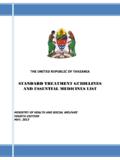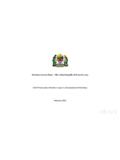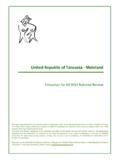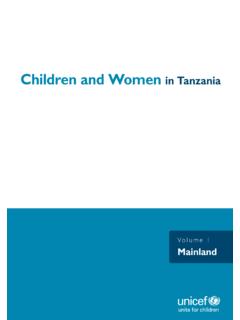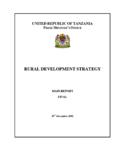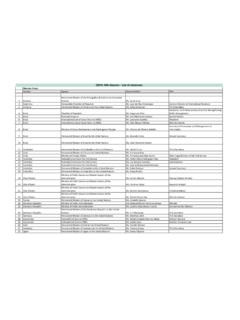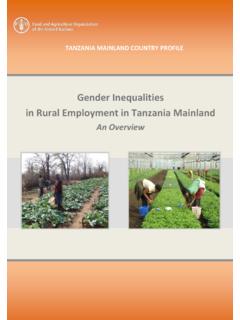Transcription of THE UNITED REPUBLIC OF TANZANIA - Tanzania …
1 - THE UNITED REPUBLIC OF TANZANIA ministry OF COMMUNITY DEVELOPMENT GENDER AND CHILDREN NATIONAL STRATEGY FOR GENDER DEVELOPMENT iiTABLE OF CONTENTS CONTENTS PAGE FOREWORD iv STATEMENT v Acronyms and Abbreviations vi CHAPTER I: BACKGROUND Introduction Layout of the NSGD Preparation of the NSGD Gender Development in TANZANIA Challenges Rationale for the NSGD Aim Goal and Objective of NSGD Links to other National Policies Definitions of Selected Gender Concepts 1 1 1 1 2 2 3 3 3-5 CHAPTER II: POLICY CONCERNS Introduction Areas of Gender Concern Institutional Framework Decision-making and Power Legal and Human Rights Education Training Economic Empowerment Employment General and Reproductive Health HIV and AIDS Food Security and Nutrition Division of Labour Information, Education and Communication Appropriate Technology Environmental Protection and Conservation Access and Ownership of Resources Gender Mainstreaming Gender/Sex Disaggregated Data Social Security Community Participation 6 6 6 7 8 9 10 11 12 13 14 15 16 17 18 18 19 20 21 21 22 23 24 Customs and Traditions Gender and Advocacy CHAPTER III.
2 IMPLEMENTATION FRAMEWORK The Framework Roles and Responsibilities The ministry of Community Development, Gender and Children Sector Ministries Central Ministries Local Authorities The Private Sector Community Development Partners CHAPTER IV: MONITORING, EVALUATION AND RESEARCH Monitoring and Evaluation Institutional Arrangements for Monitoring and Evaluation Research CHAPTER V: LOGICAL FRAMEWORK OF THE NSGD AND MATRIX Logical Framework of the National Strategy for Gender Development Annex 25 25 25 25 25 25 26 26 26 27 27 28 29 30-72 ivFOREWORD NATIONAL GENDER STRATEGY TANZANIA recognizes that gender inequality is a major obstacle to socio-economic and political development of its peoples. Many studies have shown that gender inequality is one of the underlying causes of low productivity as it does, among other things, hamper the participation of at least half of the country s population.
3 In recognition of this fact the government of the UNITED REPUBLIC of TANZANIA has taken various measures to ensure equality of all its citizens and, in particular, gender equality and gender equity. The ministry of Community Development, Gender and Children was established in 1990 as the national machinery for spearheading gender development in the country. The ministry , among other things, has facilitated the formulation of the Women and Gender Development Policy (2000). The aim of this policy is to ensure that the gender perspective is mainstreamed into all policies, programmes and strategies. In order to meet this objective, the national machinery initiated the establishment of gender focal points in ministries, independent government departments, regional and local authorities. These focal points in turn will be responsible for gender mainstreaming in their respective plans and programmes, while working with the national machinery, which has a coordinating role in gender development.
4 This, together with other legislative, administrative and affirmative actions has enabled TANZANIA to record remarkable achievements in gender development. Notable areas in this regard are education, health and water; economic empowerment and participation in decision-making. Despite these achievements TANZANIA as a nation is still faced with a number of challenges. These challenges cannot be overcome without ensuring that all stake holders play their role in attaining that goal of gender equity and gender equality, as sine qua non for sustainable social and economic development. It is in this regard that the National Strategy for Gender Development (NSGD) has been put in place. The National Strategy for Gender Development (NSGD) highlights the major issues of concern to gender equality while exposing the challenges ahead. It thus provides guidance on interventions to be made and identifies roles of various actors and stakeholders.
5 The NSGD also suggests co-ordination mechanisms that will facilitate the participation of the various actors, and how they could create the requisite linkages. It is hoped that the NSGD will not only make implementation of the Women and Gender Development more focused, but it will also make that implementation more result-oriented. I therefore, call upon all actors and stakeholders to identify their roles within the NSGD and play their part committedly. We acknowledge with thanks the inputs of all actors and stakeholders who so diligently worked to have this Strategy in place. Special tribute is paid to the World Bank who supported the ground who works for the Strategy and the UNITED Nations Fund for Population Activities co-ordinated the joint efforts of our ministry and development partners. We look forward to yet further co-operation between us. Dr. Asha-Rose Migiro MINISTER FOR COMMUNITY DEVELOPMENT, GENDER AND CHILDREN v STATEMENT NATIONAL STRATEGY FOR GENDER DEVELOPMENT The National Strategy for Gender Development is a step forward among other things towards laying foundation in promoting gender equality and equity in the country.
6 It is one of the efforts in implementing the Platform for Action and the Fourth World Conference on Women. The government of TANZANIA has made a firm political commitment to support any initiatives that are focused at alleviating gender inequality in economic, education, training and employment at all levels. Despite the various measures being undertaken to address gender equality and equity, the government still faces a number of challenges that continues to hamper its capacity in implementing its role of providing institutional support to all sectors to attain their missions with gender responsiveness. To be able to play this role effectively and efficiently more effort is needed. That is why the MCDGC has developed the NSGD with the objective of accelerating the attainment of gender equality in the Country. The NSGD highlights the major issues of concern to gender equality, challenges and provides guidance on the interventions and identifies the roles of various actors and the coordination mechanisms to facilitate the participation and linkages of the various actors.
7 The NSGD Matrix presents the logical framework and includes objectives strategies, activities, performance indicators, actors and timeframe. The activities identified in the matrix are not exhaustive. Actors are responsible for identifying specific detailed sectoral activities that will be taken up during the implementation of the NSGD also in line with the National Strategy for Growth and Reduction of Poverty. Gender as a crosscutting issue, has many actors who are playing various roles in all aspects of development. The main actors are government institutions, private sector, civil society communities and development partners The success of the NSGD will however depend on the ability of each of the various actors to implement it effectively while recognizing the need to have in place strong Women National Machinery which is at present the ministry of Community Development Gender and Children.
8 The ministry is committed to ensuring gender equality and parity in TANZANIA for coordinating and linking the activities of the various actors. Hilda Ausi Gondwe PERMANENT SECRETARY ministry OF COMMUNITY DEVELOPMENT GENDER AND CHILDREN viACRONYMS AND ABBREVIATIONS AIDS Acquired Immunodeficiency Syndrome ASDS BPA Agricultural Sector Development Strategy Beijing Platform of Action CBO CDA Community Based Organization Community Development Assistant CSO Civil Society Organization CDOs Community Development Officers CEDAW Convention on the Elimination of All Forms of Discrimination Against Women CRC Convention on the Rights of the Child COBET DPs EAC Complementary Basic Education in TANZANIA Development Partners East African Community EPT Education and Training Policy GOT Government of TANZANIA FGM Female Genital Mutilation GSES Girls Secondary Education Support HTP Harmful Traditional Practices HIV Human Immunodeficiency Virus IEC Information Education and Communication ITN Insecticide Treated Nets IMR Infant Mortality Rate LGAs Local Government Authorities LRC Law Reform Commission
9 MOA ministry of Agriculture MCDGC ministry of Community Development, Gender and Children MOF ministry of Finance MEM ministry of Energy and Minerals MCM ministry of Cooperatives and Marketing MNRT ministry of Natural Resources and Tourism MIT ministry of Industry and Trade MOEC ministry of Education and Culture MOHA ministry of Home Affairs MOH ministry of Health MOAFS ministry of Agriculture and Food Security MJCA ministry of Justice and Constitutional Affairs MLHS ministry of Lands and Human Settlement MLYDS ministry of Labour, Youth Development and Sports MWLD ministry of Water and Livestock Development MSTHE ministry of Science, Technology and Higher Education MOW ministry of Works MMR Maternal Mortality Rate NSGD National Strategy for Gender Development NBS National Bureau of Statistics NGO Non Governmental Organization PRSP Poverty Reduction Strategy Paper PMO Prime Minister s Office PO-CSD President s Office Civil Service Department PO-RALG President s Office Regional Administration and Local Government PO-PP President s Office Planning and Privatization viiSOSPA Sexual Offences (Special Provisions)
10 Act SACCOS Savings and Credit Cooperative Societies SADC STD Southern Africa Development Community Sexually Transmitted Diseases TACAIDS TANZANIA Commission for AIDS TDHS TANZANIA Demographic Household Survey TIE TANZANIA Institute of Education TFNC TANZANIA Food and Nutrition Centre TFTW Training Fund for TANZANIA Women TRCHS TANZANIA Reproductive and Child Health Survey TV Television U5MR Under Five Mortality Rate VETA Vocational Education and Training Authority WIC Women Information Center 1 CHAPTER I: BACKGROUND Introduction The socio-economic development of TANZANIA is dependent on the full utilization of its human resource, both women and men. The society realizes that the continued marginalization and under-utilization of women who constitute percent (population census 2002) of the population is a major obstacle to rapid socio-economic development of the country. The Government has taken measures to address gender concerns in the Constitution of the UNITED REPUBLIC of TANZANIA , macro and micro policies, strategies and programmes.
